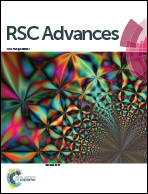Ecofriendly synthesis and characterization of carboxylated GAP copolymers†
Abstract
Carboxylated GAP copolymers (polyGA-carboxylate) compounds (1–7), were synthesized by the simultaneous substitution reaction with PECH, sodium azide, and sodium carboxylate in DMSO. The synthesized compounds (1–7) were characterized by various analysis tools, such as Fourier transform infrared (FT-IR), inverse gated decoupling 13C-nuclear magnetic resonance (13C NMR), gel permeation chromatography (GPC), thermogravimetric analysis (TGA), differential scanning calorimetry (DSC), calorimetry, and friction and impact sensitivity. These poly(GA-carboxylate) compounds (1–7) have better thermal properties owing to their lower glass transition temperatures, from −48 °C to −55 °C, compared to glycidyl azide polymer (GAP) (−49 °C) and similar first thermal decomposition temperatures (228–230 °C) in comparison to GAP (227 °C), regardless of the introduction of the carboxylate group in GAP. Moreover, poly(GA0.8-butyrate0.2) and poly(GA0.8-decanoate0.2) have higher heats of combustion (2331 and 2976 kJ mol−1) and negative formation enthalpies (−0.75 and −2.02 kJ g−1), while GAP has a lower heat of combustion (2029 kJ mol−1) and positive formation enthalpy (1.33 kJ g−1). Therefore, poly(GA-carboxylate) could be a good candidate for the polymeric binder in solid propellants.



 Please wait while we load your content...
Please wait while we load your content...